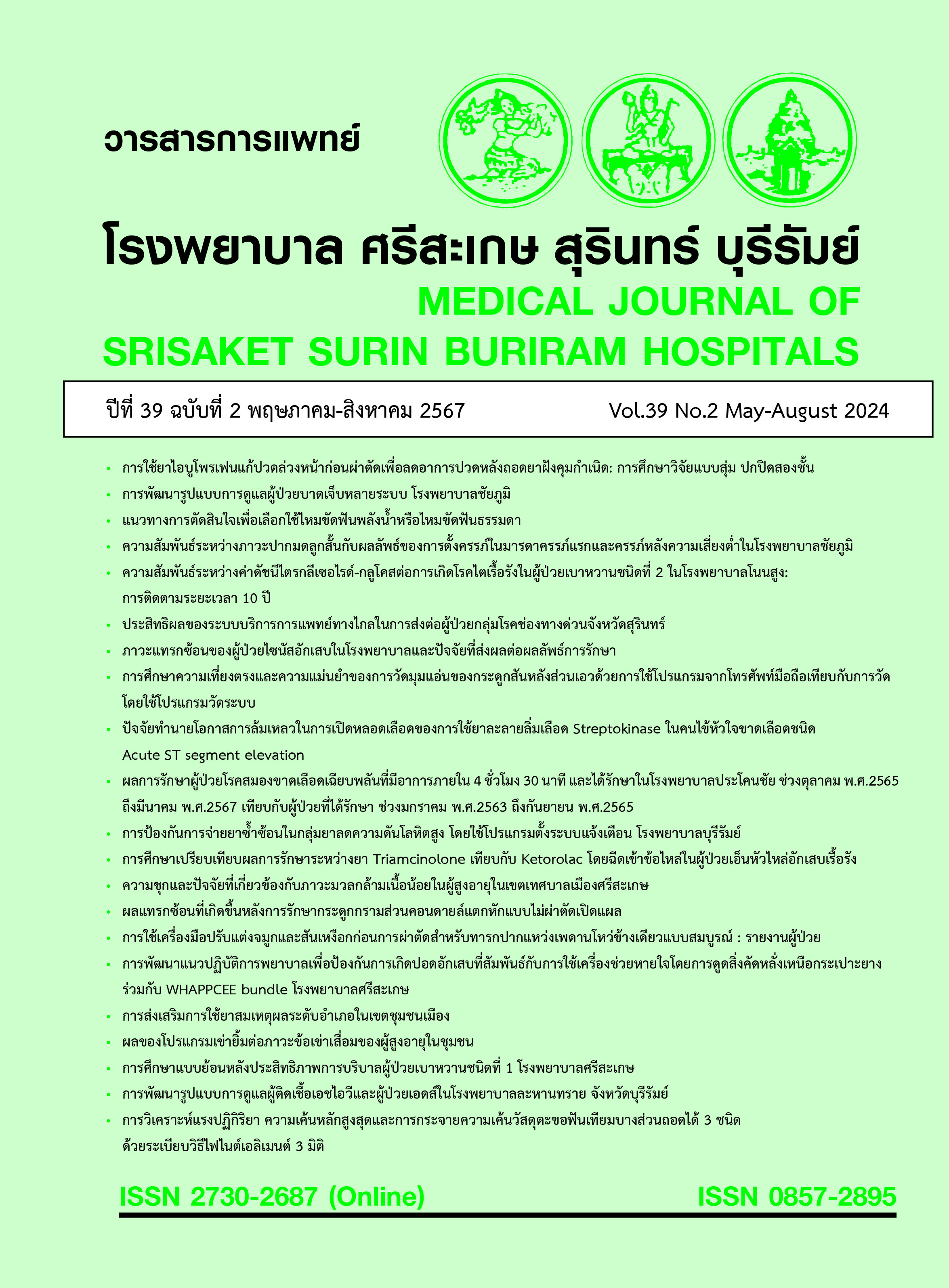ความสัมพันธ์ระหว่างค่าดัชนีไตรกลีเซอไรด์-กลูโคสต่อการเกิดโรคไตเรื้อรังในผู้ป่วยเบาหวานชนิดที่ 2 ในโรงพยาบาลโนนสูง: การติดตามระยะเวลา 10 ปี
Main Article Content
บทคัดย่อ
หลักการและเหตุผล: ความต้านทานต่ออินซูลิน (IR) เป็นหนึ่งในปัจจัยเสี่ยงของโรคไตเรื้อรัง (CKD) และโรคเบาหวาน ดัชนีไตรกลีเซอไรด์-กลูโคส (TyG) ถือเป็นทางเลือกในการทำนายความสัมพันธ์ระหว่างดัชนี TyG และความรุนแรงของโรคไตเรื้อรังในผู้ป่วยเบาหวาน
วัตถุประสงค์: เพื่อศึกษาความสัมพันธ์ระหว่างค่าดัชนีไตรกลีเซอไรด์-กลูโคสต่อการเกิดโรคไตเรื้อรังในผู้ป่วยเบาหวานชนิดที่ 2 ในโรงพยาบาลโนนสูง
วิธีการศึกษา: เป็นการศึกษาข้อมูลแบบ retrospective study ศึกษาในประชากรผู้ป่วยเบาหวานชนิดที่ 2 ที่ถูกวินิจฉัยว่าเป็นโรคเบาหวาน ในโรงพยาบาลโนนสูง ระหว่างปี พ.ศ. 2555 - พ.ศ. 2557 และถูกติดตามค่าผลทางห้องปฏิบัติการ ค่าดัชนีไตรกลีเซอไรด์-กลูโคส โดยการ TyG, triglyceride-glucose index = (TyG = ln [Fasting triglyceride (mg / dl) x Fasting glucose (mg / dl)] / 2) ไปข้างหน้าอีก 10 ปี เพื่อดูการพัฒนาการเกิดโรคไตเรื้อรัง วิเคราะห์ข้อมูลแบบ survival analysis
ผลการศึกษา: ผู้ป่วยเบาหวานที่สามารถติดตามได้ครบระยะเวลา 10 ปี จำนวน 115 ราย พบผู้ป่วยเป็นโรคไตเรื้อรัง 70 รายคิดเป็นร้อยละ 60.9 มัธยฐานการพัฒนาโรคเป็นโรคไตเรื้อรัง 5.2 ปี จุดตัดที่เหมาะสมในการทำนายค่า baseline triglyceride-glucose index คือ 5.1 ซึ่งมีความไว ร้อยละ 54.0 ค่าความจำเพาะ ร้อยละ 58.0 ค่า ROC = 0.6 เมื่อวิเคราะห์ปัจจัยแบบ multiple cox regression พบว่า ปัจจัยที่ส่งผลผู้ป่วยเบาหวานต่อการพัฒนาป่วยเป็นโรคไตเรื้อรังคือ อายุมากกว่า 60 ปี (ad.HR=3.4 เท่า; 95%CI 1.8-6.5; p-value <0.01) โรคประจำตัวความดันโลหิตสูง (ad.HR=2.0 เท่า; 95%CI 1.0-3.7; p-value =0.03) และค่า triglyceride-glucose index ในปีแรกทีเพิ่มขึ้น (ad.HR=2.5 เท่า; 95%CI= 1.0-6.3; p-value =0.04)
สรุปผล: เมื่อป่วยเป็นเบาหวานชนิดที่ 2 ที่ระยะเวลา 5.2 ปี สามารถพัฒนาเป็นโรคไตเรื้อรังได้ อย่างไรก็ตามควรเฝ้าระวังผู้ป่วยเบาหวานชนิดที่ 2 ในกลุ่มอายุ 60 ปีขึ้นไป มีโรคประจำตัวความดันโลหิตสูง และค่า baseline ของไตรกลีเซอไรด์-กลูโคสเพื่อลดโอกาสการพัฒนาการเกิดโรคไตเรื้อรังในกลุ่มผู้ป่วยเบาหวานได้
Article Details

อนุญาตภายใต้เงื่อนไข Creative Commons Attribution-NonCommercial-NoDerivatives 4.0 International License.
เอกสารอ้างอิง
World Health Organization. Diabetes. [Internet]. 2021 [cited 2023 Jul 22]. Available from:URL: https://www.who.int/news-room/fact-sheets/detail/diabetes.
กรมควบคุมโรค กระทรวงสาธารณสุข. รายงานสถิติโรคเบาหวาน ปี 2563. [อินเตอร์เน็ต]. 2563. [สืบค้นเมื่อ 8 กรกฎาคม 2566]; ค้นได้จาก:URL:https://www.thaincd.com/2017/index.php/news/8063.html.
สุมาลี นิมมานิตย์. โรคเบาหวานกับไต ตอนที่ 1. [อินเตอร์เน็ต]. 2553. [สืบค้นเมื่อ 8 กรกฎาคม 2566]. ค้นได้จาก:URL: https://www.si.mahidol.ac.th/th/healthdetail.asp?aid=316.
American Diabetes Association. Standards of Medical Care in Diabetes-2021 Abridged for Primary Care Providers. Clin Diabetes 2021;39(1):14-43. doi: 10.2337/cd21-as01.
Zoppini G, Targher G, Chonchol M, Ortalda V, Abaterusso C, Pichiri I, et al. Serum uric acid levels and incident chronic kidney disease in patients with type 2 diabetes and preserved kidney function. Diabetes Care 2012;35(1):99-104. doi: 10.2337/dc11-1346.
American Heart Association, Inc. Triglycerides: Frequently Asked Questions. [Internet]. Triglycerides: Frequently Asked Questions. [Cited 2024 Jul 8]. Available from:URL: https://www.heart.org/en/health-topics/cholesterol/about-cholesterol/triglycerides
Sarwar N, Danesh J, Eiriksdottir G, Sigurdsson G, Wareham N, Bingham S, et al. Triglycerides and the risk of coronary heart disease: 10,158 incident cases among 262,525 participants in 29 Western prospective studies. Circulation 2007;115(4):450-8. doi: 10.1161/CIRCULATIONAHA.106.637793.
Low S, Pek S, Moh A, Ang K, Khoo J, Shao YM, et al. Triglyceride-glucose index is prospectively associated with chronic kidney disease progression in Type 2 diabetes - mediation by pigment epithelium-derived factor. Diab Vasc Dis Res 2022;19(4):14791641221113784. doi: 10.1177/14791641221113784.
Vasques AC, Novaes FS, de Oliveira Mda S, Souza JR, Yamanaka A, Pareja JC, et al. TyG index performs better than HOMA in a Brazilian population: a hyperglycemic clamp validated study. Diabetes Res Clin Pract 2011;93(3):e98-e100. doi: 10.1016/j.diabres.2011.05.030.
Duan S, Zhou M, Lu F, Chen C, Chen S, Geng L, et al. Triglyceride-glucose index is associated with the risk of chronic kidney disease progression in type 2 diabetes. Endocrine 2023;81(1):77-89. doi: 10.1007/s12020-023-03357-z.
Kidney Disease: Improving Global Outcomes (KDIGO) CKD Work Group. KDIGO 2024 Clinical Practice Guideline for the Evaluation and Management of Chronic Kidney Disease. Kidney Int 2024;105(4S):S117-S314. doi: 10.1016/j.kint.2023.10.018.
Simental-Mendía LE, Rodríguez-Morán M, Guerrero-Romero F. The product of fasting glucose and triglycerides as surrogate for identifying insulin resistance in apparently healthy subjects. Metab Syndr Relat Disord 2008;6(4):299-304. doi: 10.1089/met.2008.0034.
Wen CP, Chang CH, Tsai MK, Lee JH, Lu PJ, Tsai SP, et al. Diabetes with early kidney involvement may shorten life expectancy by 16 years. Kidney Int 2017;92(2):388-96. doi: 10.1016/j.kint.2017.01.030.
Cheru A, Edessa D, Regassa LD, Gobena T. Incidence and predictors of chronic kidney disease among patients with diabetes treated at governmental hospitals of Harari Region, eastern Ethiopia, 2022. Front Public Health 2024;11:1290554. doi: 10.3389/fpubh.2023.1290554.
Kim WJ, Kim SS, Bae MJ, Yi YS, Jeon YK, Kim BH, et al. High-normal serum uric acid predicts the development of chronic kidney disease in patients with type 2 diabetes mellitus and preserved kidney function. J Diabetes Complications 2014;28(2):130-4. doi: 10.1016/j.jdiacomp.2013.11.006.
Salinero-Fort MA, San Andrés-Rebollo FJ, de Burgos-Lunar C, Gómez-Campelo P, Chico-Moraleja RM, López de Andrés A, et al. Five-year incidence of chronic kidney disease (stage 3-5) and associated risk factors in a Spanish cohort: the MADIABETES Study. PLoS One 2015;10(4):e0122030. doi: 10.1371/journal.pone.0122030.
Salazar J, Bermúdez V, Calvo M, Olivar LC, Luzardo E, Navarro C, et al. Optimal cutoff for the evaluation of insulin resistance through triglyceride-glucose index: A cross-sectional study in a Venezuelan population. F1000Res 2017;6:1337. doi: 10.12688/f1000research.12170.3.
Jiang Y, Lai X. Association between the triglyceride glucose index, triglyceride-glucose body mass index and diabetic kidney disease in adults with newly diagnosed type 2 diabetes. Front Med (Lausanne) 2024;11:1328601. doi: 10.3389/fmed.2024.1328601.
Damtie S, Biadgo B, Baynes HW, Ambachew S, Melak T, Asmelash D, et al. Chronic Kidney Disease and Associated Risk Factors Assessment among Diabetes Mellitus Patients at A Tertiary Hospital, Northwest Ethiopia. Ethiop J Health Sci 2018;28(6):691-700. doi: 10.4314/ejhs.v28i6.3.
Coresh J, Selvin E, Stevens LA, Manzi J, Kusek JW, Eggers P, et al. Prevalence of chronic kidney disease in the United States. JAMA 2007;298(17):2038-47. doi: 10.1001/jama.298.17.2038.
Nitta K, Okada K, Yanai M, Takahashi S. Aging and chronic kidney disease. Kidney Blood Press Res 2013;38(1):109-20. doi: 10.1159/000355760.
Couser WG, Remuzzi G, Mendis S, Tonelli M. The contribution of chronic kidney disease to the global burden of major noncommunicable diseases. Kidney Int 2011;80(12):1258-70. doi: 10.1038/ki.2011.368.
Ren X, Jiang M, Han L, Zheng X. Association between triglyceride-glucose index and chronic kidney disease: A cohort study and meta-analysis. Nutr Metab Cardiovasc Dis 2023;33(6):1121-8. doi:10.1016/j.numecd.2023.03.026.
Sakoda T, Akasaki Y, Sasaki Y, Kawasoe S, Kubozono T, Ikeda Y, et al. Triglyceride-glucose index predicts future chronic kidney disease development in all populations, including normotensive and isolated diastolic hypertension. Hypertens Res 2024;47(1):149-56. doi: 10.1038/s41440-023-01507-4.
Pan Y, Zhong S, Zhou K, Tian Z, Chen F, Liu Z, et al. Association between Diabetes Complications and the Triglyceride-Glucose Index in Hospitalized Patients with Type 2 Diabetes. J Diabetes Res 2021;2021:8757996. doi: 10.1155/2021/8757996


